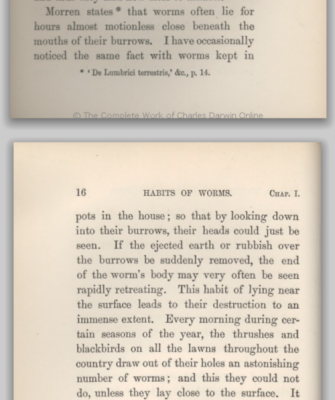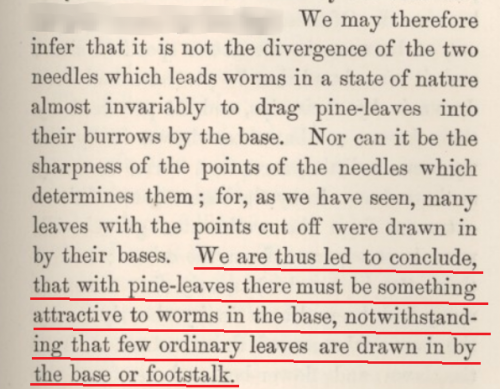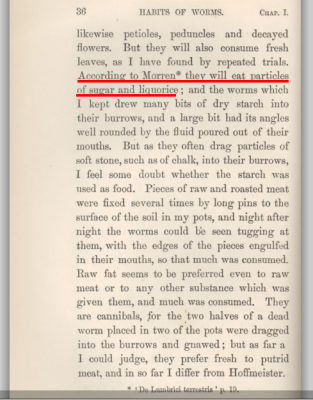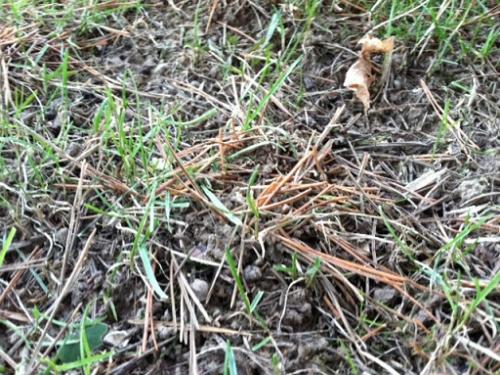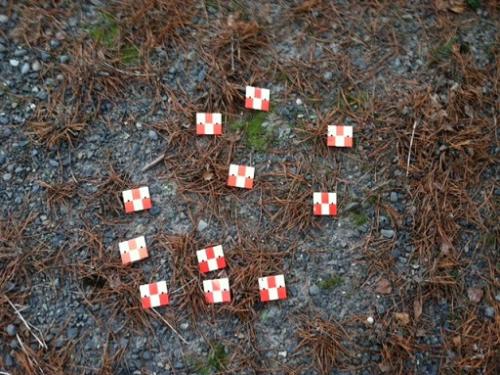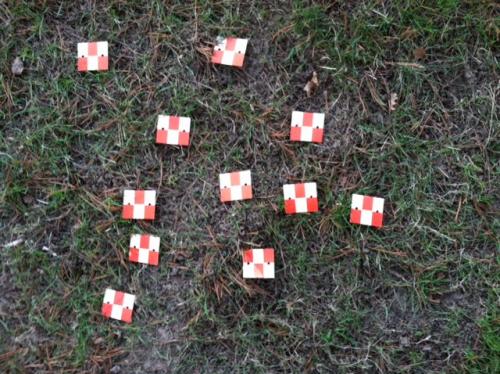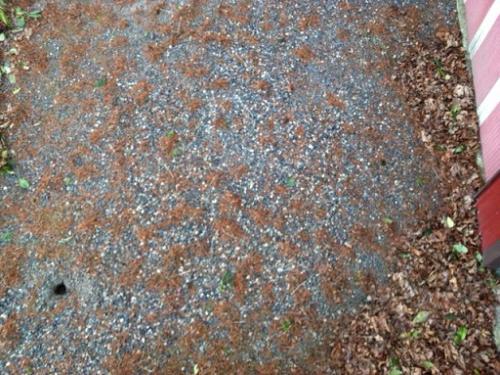-
Posts
978 -
Joined
-
Last visited
Content Type
Profiles
Forums
Events
Everything posted by arc
-
But that's the best part!
-

Goodbye and thanks for all the fish.
arc replied to Ophiolite's topic in Suggestions, Comments and Support
Maybe . . . . .I'm not gonna say. -

Goodbye and thanks for all the fish.
arc replied to Ophiolite's topic in Suggestions, Comments and Support
Ya . . . No kidding! . . . . . . . . .S a a a y . . . . Wait . . a . . . minute . . . . . . -
Thanks String. That old type does have a certain quaintness to it though.
-
I think those needles may have a purpose other than or in addition to a deterrent strategy. As noted the worms spend a considerable amount of time at their burrow's opening. Those needle would give the worm a slight advantage in the sense it would cause the bird to be more cautious in the last few cm of its approach. But more important they would behave as the whiskers on a mouse and forewarn the worm of the approaching bird. Striking the needles first would undoubtedly increase the worms perception of the imminent danger and give it that fraction of a second advantage it would not have without those needles sticking up above its opening. They are both a deterrent and an early warning device. http://www.deanza.edu/faculty/mccauley/6a-labs-plants-04.htm "Phloem transports the sugars that are produced in photosynthesis from the leaves to the rest of the plant. The phloem cells are small and thin-walled; in this slide, as in many others, the phloem cells appear blue." Given the choice I can't see why the worm wouldn't take the opportunity to sample the sweetness of the needle by tasting the sugars at the base or fascicle end of the needle. It may be an opportunity to reject a bad needle and not waste the energy to transport it. edit spelling.
-
Well, Darwin thought there may be something on the knob. Yet, it has that certain "STAY AWAY OR I'LL POKE YOUR EYES OUT" thing going for it. Kind of a "The more needles you has sticking out of your burrow the better chance you have to live and breed" Did this just evolve as a deterrence. But then they will just get fat and stay inside playing video games.
-
I think it is the shape of the knob and the grip it provides but wouldn't it be something if it was a subtle sweet sugar taste that the worm can detect in those crevasse of the knob where sap would have passed between the needle (leaf) and the branch.
-
About those pine needles and why they are pulled into the burrow by there base, that link by Acme; http://darwin-online.org.uk/converted/pdf/1881_Worms_F1357.pdf Chapter II has many observations of the worms and their interactions with pine needles. Page 77 has this observation; They (C. Darwin and his son Francis) had fixed the pointed ends together in various ways to decipher the selection processes that the worms used in handling the needles and the reasons behind the observed preference the worms had.
-
I understand, thank you. That external agent is the mantle and the (hydraulic) magmatic fluid between the crust and mantle. They are always there supporting the crust throughout its various degrees of compressive energies. "Next, with the slabs in place against each other and the buttresses on either end, the frame is fractionally lowered. I think everyone would agree the slabs would begin to experience compression. We could add more slabs, like say dozens of bricks, and make it resemble an almost flat arch but as experience shows these arrangements are unstable and the level of compression needed to accomplish self support will divert to a kinetic direction of force change, usually upwards in the center as the span fails and falls on either side of the vertical rupture." (A nice analogy to a mountain range in a continental interior BTW.) In the model that I described above, I stated; the frame is fractionally lowered. This was to express that the slabs were never fulling unsupported, and actually the opposite is true. They are mostly supported and attain very little compression as compared to what there would be if they were mostly or completely unsupported. The current observable evidence is that there is compression in the crust that is derived from and in the form of gravitational potential energy. http://ceas.iisc.ernet.in/~aghosh/Ghosh_geology06.pdf Gravitational potential energy of the Tibetan Plateau and the forces driving the Indian plate Attreyee Ghosh William E. Holt Department of Geosciences, State University of New York, Stony Brook, New York 11790, USA Lucy M. Flesch* Department of Terrestrial Magnetism, Carnegie Institution of Washington, Washington, DC 20015, USA A. John Haines† Bullard Laboratories, University of Cambridge, Cambridge CB3 0EZ, UK ABSTRACT "We present a study of the vertically integrated deviatoric stress field for the Indian plate and the Tibetan Plateau associated with gravitational potential energy (GPE) differences. Although the driving forces for the Indian plate have been attributed solely to the mid-oceanic ridges that surround the entire southern boundary of the plate, previous estimates of vertically integrated stress magnitudes of 6–7 1012 N/m in Tibet far exceed those of 3 1012 N/m associated with GPE at mid-oceanic ridges, calling for an additional force to satisfy the stress magnitudes in Tibet. We use the Crust 2.0 data set to infer gravitational potential energy differences in the lithosphere. We then apply the thin sheet approach in order to obtain a global solution of vertically integrated deviatoric stresses associated only with GPE differences. Our results show large N-S extensional deviatoric stresses in Tibet that the ridge-push force fails to cancel." . . . ."there is no complete dynamic explanation for this large GPE of the Tibetan Plateau and the relatively fast movement of the Indian plate. There is no apparent down going slab attached to the Indian plate that might assist in driving the plate into Eurasia through the slab pull mechanism" . . . . . . . . . "However, the ridge push, or vertically integrated deviatoric stress magnitude, which is 3 1012 N/m (Richardson, 1992; Harper, 1975; Lister; 1975; Parsons and Richter, 1980), is not sufficient to satisfy inferred stress magnitudes of 6–7 1012 N/m that result from GPE differences between the Tibetan Plateau and the surrounding lowlands (Molnar and Lyon-Caen, 1988). An additional force is required to explain the disparity between the excess GPE of Tibet relative to that of the mid-oceanic ridges" . . . . . . . ."Lithospheric density variations associated with the support of the high topography of the Tibetan Plateau give rise to lithospheric body forces and hence stresses. Although the sources of stress that drive plate motions have been ascribed to many parameters (Forsyth and Uyeda, 1975), from the point of view of stress continuity and force balance, the stresses that drive lithospheric motion arise from two sources: (1) gravity acting on density variations within the lithospheric shell on Earth, and (2) gravity acting on density variations deeper than the lithospheric shell. The latter gives rise to tractions (radial and tangential) that act on the base of the lithosphere, affecting the stress field of the lithosphere and producing dynamic topography. The former involves density variations associated with support of nondynamic components of topography". Conclusions; . . "It is clear that something is missing as a driving force that does not have its source within the lithospheric shell." "calling for an additional force to satisfy the stress magnitudes in Tibet." This would be the marginal but still present ~ compression that I expect to be present at all times within the entire plate matrix. "(1) gravity acting on density variations within the lithospheric shell on Earth, and (2) gravity acting on density variations deeper than the lithospheric shell." That describes exactly what I want my model to portray and to provide. The "density variations deeper than the lithospheric shell." providing that fractional change in support of the overlaying lithosphere or in my example above, the concrete slabs. Edit: underline
-
Mantle convection will be overturned as the preeminent theory of the geodynamic evolution of the Earth . . . . . or maybe it's the following year?
-
Well, as I said in post #349; I have been chastised many times for posting to much at once. And it was probably justified, as it was difficult for anyone to commit to reading that much material for just a post response. The balloon analogy doesn't work very well for this. We are dealing with pieces that are large and heavy yet deformable under extreme energies. I would think we could imagine, say, taking several large slabs of concrete and placing them over a support frame or form with a very subtle radius. The opposing ends of the slab assembly are buttressed in a manner that can support more weight or horizontal pressure than is needed for this experiment. Next, with the slabs in place against each other and the buttresses on either end, the frame is fractionally lowered. I think everyone would agree the slabs would begin to experience compression. We could add more slabs, like say dozens of bricks, and make it resemble an almost flat arch but as experience shows these arrangements are unstable and the level of compression needed to accomplish self support will divert to a kinetic direction of force change, usually upwards in the center as the span fails and falls on either side of the vertical rupture. (A nice analogy to a mountain range in a continental interior BTW.) This analogy when expanded to a global matrix of irregular shaped and sized tectonic plates works rather well. The evidence of the outward displacement of the global plate matrix is not only seen in the simultaneous opening of divergent boundaries but in the observed evidence of the progression in movement of convergent boundaries in the opposite direction of the subducting plate. As if the convergent trench was being pulled as shear forces from below were extending not only the subducting plate but the entire plate matrix. This progression is currently observed at both convergent and divergent plate boundaries. http://dx.doi.org/10...099.2013.835283 Seismology, thermodynamics and classical physics—the physics associated with the names of Fourier, Debye, Born, Gr€uneisen, Kelvin, Rayleigh, Rutherford, Ramberg and Birch—show that ambient shallow mantle under large long-lived plates is hundreds of degrees hotter than in the passive upwellings that fuel the global spreading ridge system, that potential temperatures in mantle below about 200 km generally decrease with depth and that deep mantle low shear wave-speed features are broad, sluggish and dome-like rather than narrow and mantle-plume-like. The surface boundary layer of the mantle is more voluminous and potentially hotter than regions usually considered as sources for intraplate volcanoes. This would suggest there is evidence that the crust/mantle boundary contains large volumes of magma that would be at play in providing a hydraulic medium between the mantle and crust, extending the crust while simultaneously extruding into the divergent boundaries as is currently being observed. The model proposes the magma is dependent on the strain energy that is simultaneously released by the mantle during it's displacement. In post #103 I wrote; My model is predictive of the statement above; The thermal expansion (of the core's liquid iron) will displace the mantle and release strain energy in the form of heat during its outward movement. The slow increase in the mantles circumference will require the crust to separate and adjust to release the continual tension. As the mantle is displaced outward the divergent plate boundaries are slowly separated, and as they do magma created from the strain energy at the crust/mantle boundary is forced under pressure into the slowly opening gap. The strain energy thermal content is produce as the mantle is forced to expand against gravity and its own viscosity, tearing its outer surface area and releasing the thermal energy. I apologize if this was too long or contained any unneeded verbiage. I must disagree, as I just showed above, a very simple mechanical model that matches the field observations perfectly, is all that is needed. And as the link that Ophiolite furnished explains; 3.2. Subduction zones "However, subduction zones are really only crudely predicted by simple convection theory, and there is much to them that is highly atypical of convection. First, if one were to only consider the strength of a cold super-viscous lithosphere, one would not expect to see subduction zones at all. Convection with purely temperature dependent viscosity typical of the Earth’s tends form a cold, hard, and immobile layer on the top, and all convective motion occurs beneath it, as if it were a rigid lid." "Indeed, Earth seems particularly anomalous since it appears to be the only terrestrial planet with prominent subduction zones. Thus, subduction initiation presents formidable problem to convection models." Convection has a formidable challenge to overcome.
-
Happy new year billiards! Hope you had a pleasant holiday. What! I do not recall ever discussing with you proto crust and the initiation of plate tectonics. No, I have avoided falling into that trap that was reiterated in the link that Ophiolite offered in post #346 as a counter argument to my demand that anyone defending convection needs to furnish some predictions of observations; http://people.earth.yale.edu/sites/default/files/files/Bercovici/51EPSL-Frontiers-PlateGen.pdf "The purpose of this review is to first briefly explain why generating plates is such a problem, and then to survey some of the various directions and progress made in trying to generate them from mantle dynamics theory" 3.2. Subduction zones "However, subduction zones are really only crudely predicted by simple convection theory, and there is much to them that is highly atypical of convection. First, if one were to only consider the strength of a cold super-viscous lithosphere, one would not expect to see subduction zones at all. Convection with purely temperature dependent viscosity typical of the Earth’s tends form a cold, hard, and immobile layer on the top, and all convective motion occurs beneath it, as if it were a rigid lid." "Indeed, Earth seems particularly anomalous since it appears to be the only terrestrial planet with prominent subduction zones. Thus, subduction initiation presents formidable problem to convection models." And I'm just following your lead on this; "For the last decade, the ‘plate-generation’ community has focused largely on explaining how and why convection looks plate-like at present. Yet little has been done to address another important feature of plate tectonics, i.e. plate evolution and rapid plate-motion changes. The plate tectonic record is filled with apparent plate-reorganization events" "Both the initiation of subduction and the asymmetry or one-sidedness of subduction remain open first-order questions. Initiation might require some sort of mechanism to weaken thick cold lithosphere, such as a rifting event" Hmm . . . Yes, . . . . someone does need to come up with a solution for that . . . . . Hello studiot, welcome back to my thread. I will be a more gracious host this time. My apologies again for not responding properly in the past. There was and is no excuse. And I extend this acknowledgment to billiards as well and anyone else who feel I acted improper towards them. My apologies to them also. '''why the crust enters compression when the core shrinks," Well, gravity. Just as the skin of an apple will wrinkle as the surface area of the hypanthium or flesh, to which it is attached, shrinks, the Earth's crust that is much more rigid will in turn begin to respond with similar compressive energies as the gravitational potential energy slowly increases from the inward displacement of the mantle. The only solution to this growing energy level is for the crust to go downward as subduction, or to go upward as mountain structures. As the article mentioned; http:// en. wikipedia.org/wiki/Craton During the early years of Earth's existence, when the planet was much hotter, greater degrees of melting at spreading oceanic ridges generated oceanic lithosphere with thick crust, much thicker than 20 km (12 mi) I believe this would suggest for a proto crust that subduction is easier to accomplish after the dynamics of many cycles of inward and outward displacement had played out on a weaker and continually weakening boundary, as apposed to the lower vulnerabilities I believe a thicker crust would have to a potential vertical rupture during the same period. The current dynamics of greater continental masses can produce mountain structures when adequate crustal gravitational potential energies are present and supplied.
-
Excellent indeed, this is the one I have been reading through the last couple of days; http://darwin-online.org.uk/EditorialIntroductions/Chancellor_Earthworms.html "Darwin’s young protégé George Romanes, to whom he had entrusted some unpublished parts of his ‘big book’ on species, reviewed Earthworms in the weekly science journalNature on 13 October. Romanes focused on Darwin’s astounding and totally original proofs of the intelligence of worms, while at the same time demonstrating that they were deaf and blind. Romanes cited, for example, Darwin’s experiments proving that worms selected which part of a leaf to pull down first into their burrows." I think that is shown currently in the way they always have the needle points going outward. Very picky behavior.
-
I'm getting a lot out of this myself. I'm planing on doing a series of images next fall, either one a day or maybe every other day of the subject area. I would like to take them from about 3 to 5 meters up. A fixed camera with remote shutter would be ideal. Make a nice slideshow of the development of the hoard piles. The area is lighted at night so a night shot would be nice if the worms are big enough to get a head count and a shot of them foraging.
-
Hey, you can go anywhere you want to on my threads, no problem.
-
Man! You really nailed that punch line!
-
I was thinking when I was writing that last post that I would like to have seen what my dad's old WWII Army corps of engineers squad would had done to solve that problem.
-
Acme, over on Airport way by Ikea is the Aloft hotel. When I was working there a rental company was called by the general contractor and told to get their #%$& lift out of the job site because they were turning it over in the next few days. The original renter was no longer on site and the construction had enclosed it into a mechanical/electrical systems area below grade with a narrow doorway into a tight hallway. To get their 3x6x18 scissor lift out it took two techs 2 days to disassemble and carry it out. For the price of an excavator I would think giving it away for free with a one or two day window for removal would work. 8 guys with hand tools and a derrick like you said should do it.
-
I'm wondering how they get all the material out of the deep hole that the digger scoops up. A bucket conveyor of some type? I watched a excavator operator load his machine into the back of his ten yard dump truck. It was quite clever using the machines own hydraulic powered extensions to raise and then even push and pull it up over the back gate into the trucks dump box. Somewhat like this: I can't believe someone hasn't come up with a solution. It cost the extra time and material removal, plus labor to bury it. An excavator manufacturer should be able to design a combined system where the machine and conveyor are able to lower the machine down and back out of work sites. If the machine can use the conveyor frame for stability there should be an reasonable way of providing the energy and traction for lifting it out of the hole.
-
But you may find "air borne particles" by typing "fart".
-
Thanks michel, I just read last night about the many animals that hoard worms and one of them was a mole.
-
OK, have some more info. The worm piles are just as plentiful in the lawn as they are in the gravel area. The lawn area has been raked over several times and most of the worm's hard work has been removed to the brush pile. (I can hear them yelling at me) The mounds are there and have the needles sticking out but most have been flattened from the lawn tractor and repeated raking. The images below were taken about 7 meters closer to the pine tree than the gravel. The red and white rectangles are 20 x 25 mm so the markers are 60 x 75 mm taken at about 120 cm below the camera. Each marker was placed to the right of each pile. The lawn is on the left and the gravel on the right. And more images showing the gravel area's density. The concentration of piles appear evenly matched between the two areas. I would expect though, because the lawn would be a much greater generator of plant and insect biomass, that the worms would benefit more in that area. I'm guessing the lawn makes up this possible discrepancy by a larger share of smaller worms distributed among the already observed density of the larger ones. As I and Acme have alluded to, the distance that the larger worms can reach out to, likely determines the distances between the piles. But I think increasing the available of the food supply could also allow higher density. I don't think they so much eliminate the worms in between as much as they deprive them and suppress their development. When I dig in the soil I see greater numbers of smaller worms, these may be the "in between the piles" worms. I imagine they spend a fare amount of time stealing while being stole from until the distances grow to leave plenty of space for surplus food in between. The wind would still be bringing continuous supplies of needles and other debris to hoard without the old order of theft by proximity. -Yes, lower area. -Well, a lot of gravel with accumulated soil in between. The worms have had to work their way through the rocks. They are also very wet from heavy rains. -The rains go down through the soil. -The gravel was put down ten years ago and gets very little compaction from vehicles. -Yes -Straight down as I can tell. Tree squirrels hoard and steal from others and are quite solitary and territorial, the males do not assist in the care of their young. Found this nice video of worms foraging, stubborn little workers.
-
Yes, I agree. It may even be more specific to areas where they are more exposed to danger. This space of mine is more open and this may in turn produce behavior that mitigates the higher risk conditions. More grab and run, back to safety under the ground. I have always assumed worms were none territorial, and although that term seems beyond their behavior the evidence so far is that they are exposing themselves to increased risk to hoard material that is not immediately consumable. I have always pictured worms as sharing space, coming up at night and feeding on dead plant matter and occasionally getting eaten by predators. Now I'm starting to think they have an innate behavior to be highly competitive (selfish) to the detriment of the other members of its own surrounding species, its not overt it just ends in some others not getting an equal amount, a disadvantage. You see something like this as a group behavior in ants and other colonizing insects, or in some vertebrates that I can think of that live in groups. To name just a few like apes, lions, jackals and of coarse humans. We call it tribalism, to the other species it is innate that their group may harass, displace, steal and even kill the other competing groups of their own species. I'm trying to think of another species that behaves as a single competitive entity that exhibits something similar to this hoarding type behavior. Maybe in the ocean somewhere. Is this hoarding an innate version of a preemptive move like the killing of a tribes primary food supply. In the case of these worms it looks like cattle rustling, or do they call it needle rustling. Yup, pretty selfish. I need to check all the cameras we have and see if there's anything I can set up on the cheap. Thanks Sensei I hope one of ours will work in that manner. Well, these started growing bigger way back before we had cold enough temperatures for heaves. And I opened one up and it had a bore hole going down past 20 cm. And when I checked the next day I found two needles in the bore hole, it seems unlikely they would work their way in by gravity alone in just one night. These images below were taken from a 10 step ladder. The little black dot on bottom left is the hole I opened. What I believe you can see in these images are the needle piles of the winners and in the empty spaces between them the losers of this game of survival. Well, we will know for sure when I get pictures of them.
-
Thanks guys, when I first started reading these things I tried what you're saying and usually found it for free on the first page or the next one, but then recently when I tried the same technique I struck out every time. I wasn't thinking the publishing time had something to do with it. This last time the material I was seeking was probably much newer and I wasn't accounting for that. I'm just pleased to know the Academia.edu is good quality. The part I like about it is the authors have really good profile pages. You can see how many members are following their work and then in turn check all of their profiles. It builds a substantial amount of confidence in their work when there are so many PhD's reading each others work. It will say on the page who else has read it and who is following that author.
-
OOPS, its late and I'm getting to rummy to think straight. That was a pretty goofy response even for me. I thought today about borrowing an automatic trail camera from a friend at work. He said a leaf turning in the wind will set it off, so it may be sensitive enough to work on a worm. I'll try in the next couple of days. Goodnight


